- Clone
- Kay-10 (See other available formats)
- Regulatory Status
- RUO
- Other Names
- Fas Ligand, FasL, Apo-1 Ligand, CD95 Ligand
- Isotype
- Mouse IgG2b, κ
- Ave. Rating
- Submit a Review
- Product Citations
- publications
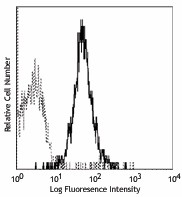
-

Mouse Fas Ligand transfected cells stained with Kay-10 PE
CD178.1 is a 40 kD Fas ligand alloantigen (designated as mFasL.1) expressed on the activated T lymphocytes, testis, and eye of selected mouse strains including C57BL/6, C3H, MRL, NOD, NZB, NZW, and SJL. It does not react with lymphoblasts from BALB/c, DBA/1, or DBA/2 mice. CD178.1 is upregulated in activated T cells upon TCR re-engagement and has been shown to induce autocrine and paracrine T cell death. CD178 expression in the eye and testis has been shown to participate in immune privilege at these sites. Functional studies suggest that mFasL.2 has higher specific activity than mFasL.1. CD178 can be cleaved from the surface by metalloproteases, and "soluble" CD178 may block the activities of membrane-bound CD178. CD178 binds to CD95 (Fas) to induce apoptotic cell death implicated in the maintenance of peripheral tolerance. CD178/CD95 interactions have been implicated in the proliferation of CD8+ cells and neutrophil extravasation, chemotaxis, and survival. The Kay-10 antibody has been reported to block CD178.1/CD95 induced apoptosis in cells derived from mice expressing this alloantigen.
Product DetailsProduct Details
- Verified Reactivity
- Mouse
- Antibody Type
- Monoclonal
- Host Species
- Mouse
- Immunogen
- C57BL/6 mouse FasL cDNA-transfected L5178Y cells
- Formulation
- Phosphate-buffered solution, pH 7.2, containing 0.09% sodium azide.
- Preparation
- The antibody was purified by affinity chromatography, and conjugated with PE under optimal conditions.
- Concentration
- 0.2 mg/ml
- Storage & Handling
- The antibody solution should be stored undiluted between 2°C and 8°C, and protected from prolonged exposure to light. Do not freeze.
- Application
-
FC - Quality tested
- Recommended Usage
-
Each lot of this antibody is quality control tested by immunofluorescent staining with flow cytometric analysis. For flow cytometric staining, the suggested use of this reagent is ≤ 1.0 µg per 106 cells in 100 µl volume. It is recommended that the reagent be titrated for optimal performance for each application.
- Excitation Laser
-
Blue Laser (488 nm)
Green Laser (532 nm)/Yellow-Green Laser (561 nm)
- Application Notes
-
Additional reported applications (for the relevant formats) include: in vitro blocking1,2 and in vivo blocking3-5, and immunohistochemical staining6 of formalin-fixed paraffin-embedded tissue sections. Fas Ligand is expressed at low density on activated cells. For most successful immunofluorescent staining results, it may be important to maximize signal over background by using a relatively bright fluorochrome-antibody conjugate (Cat. No. 106806) or by using a high sensitivity, three-layer staining technique (e.g., including biotinylated anti-mouse IgG (Cat. No. 405303) second step , followed by SAv-PE (Cat. No. 405204)). The Ultra-LEAF™ purified antibody (Endotoxin <0.01 EU/µg, Azide-Free, 0.2 µm filtered) is recommended for functional assays (Cat. No. 106809 and 106810).
-
Application References
(PubMed link indicates BioLegend citation) -
- Kayagaki N, et al. 1997. P. Natl. Acad. Sci. USA 94:3914.
- Kobata T, et al. 1997. Immunology 92:206.
- Hattori K, et al. 1998. Blood 91:4051.
- Takeda Y, et al. 1998. Diabetologia 41:315.
- Kim YH, et al. 1999. Eur. J. Immunol. 29:455.
- Takeda Y, et al. 1998. Diabetologia 41:315.
- Product Citations
-
- RRID
-
AB_2246643 (BioLegend Cat. No. 106805)
Antigen Details
- Structure
- TNF superfamily Fas ligand alloantigen, 40 kD
- Distribution
-
Activated T cells, spleen, testis, eye of some selected mouse strains (C57BL/6, C3H, NZB, NZw, MRL)
- Function
- Induces apoptosis
- Ligand/Receptor
- Fas (CD95)
- Cell Type
- T cells, Tregs
- Biology Area
- Apoptosis/Tumor Suppressors/Cell Death, Cell Biology, Immunology, Neuroscience
- Molecular Family
- CD Molecules
- Antigen References
-
1. Barclay A, et al. 1997. The Leukocyte Antigen FactsBook Academic Press.
2. Nagata S. 1999. Annu. Rev. Genet. 33:209.
3. Takahashi T, et al. 1994. Cell 76:969.
4. Hill LL, et al. 1999. Science 285:898.
5. Kayagaki N, et al. 1997. P. Natl. Acad. Sci. USA 94:3914. - Gene ID
- 14103 View all products for this Gene ID
- UniProt
- View information about CD178.1 on UniProt.org
Related FAQs
- What type of PE do you use in your conjugates?
- We use R-PE in our conjugates.
Other Formats
View All CD178.1 Reagents Request Custom Conjugation| Description | Clone | Applications |
|---|---|---|
| LEAF™ Purified anti-mouse CD178.1 (FasL) | Kay-10 | FC |
| PE anti-mouse CD178.1 (FasL) | Kay-10 | FC |
| Ultra-LEAF™ Purified anti-mouse CD178.1 (FasL) | Kay-10 | FC |
Customers Also Purchased
Compare Data Across All Formats
This data display is provided for general comparisons between formats.
Your actual data may vary due to variations in samples, target cells, instruments and their settings, staining conditions, and other factors.
If you need assistance with selecting the best format contact our expert technical support team.
-
LEAF™ Purified anti-mouse CD178.1 (FasL)
_Antibody_1_FC_090407.jpg&Width=150&altFmImage_path=&Crop=5)
Mouse Fas Ligand transfected cells stained with LEAF™ purifi... -
PE anti-mouse CD178.1 (FasL)
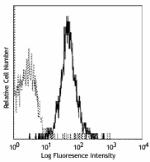
Mouse Fas Ligand transfected cells stained with Kay-10 PE -
Ultra-LEAF™ Purified anti-mouse CD178.1 (FasL)
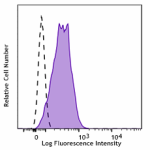
Mouse FasL transfected cell line stained with CD178.1 (FasL)...











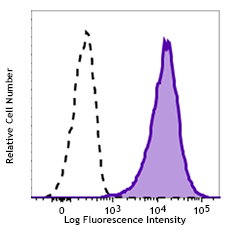
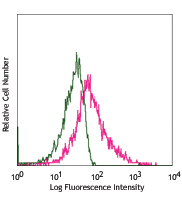
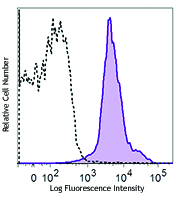



Follow Us